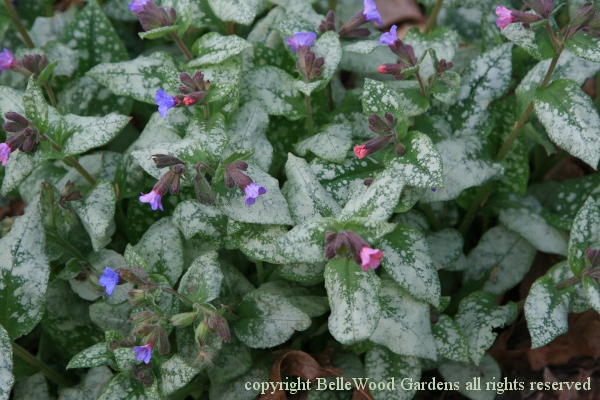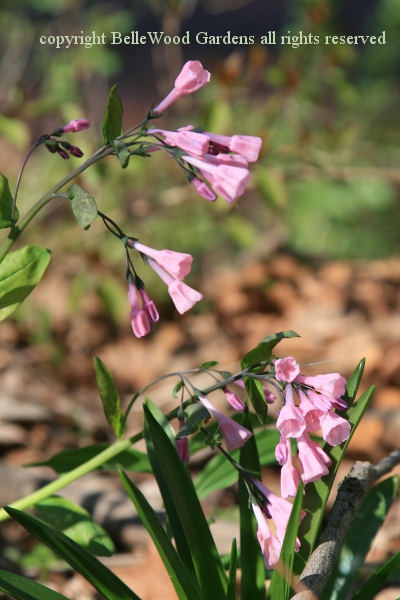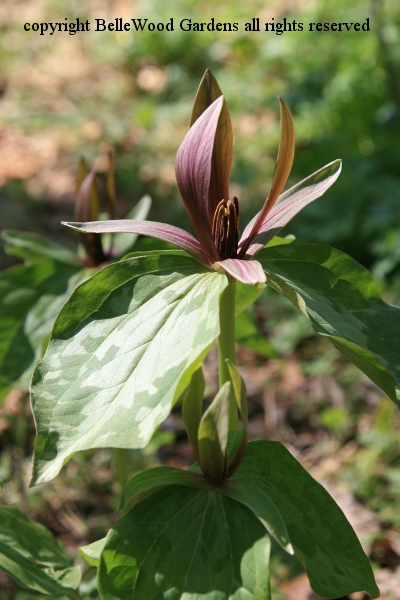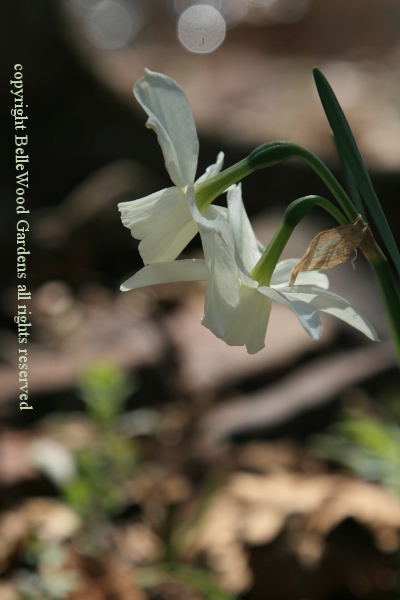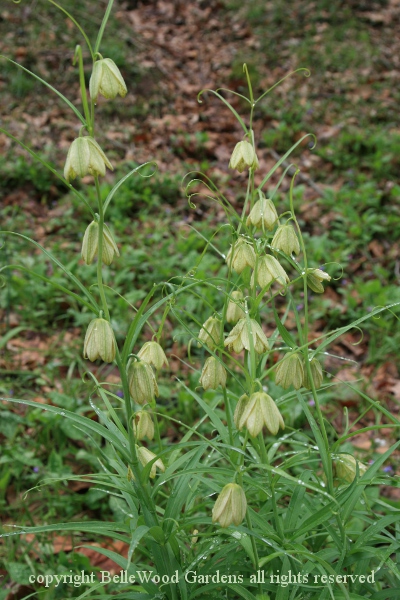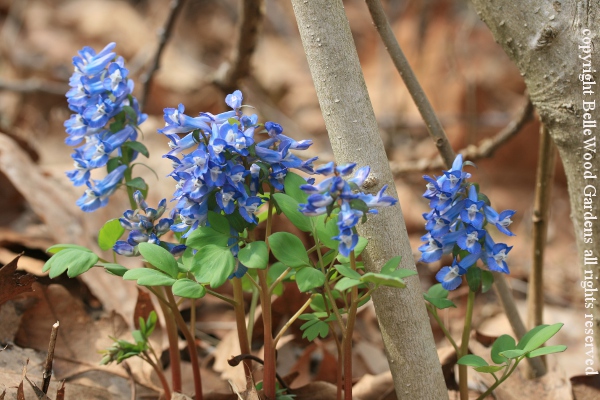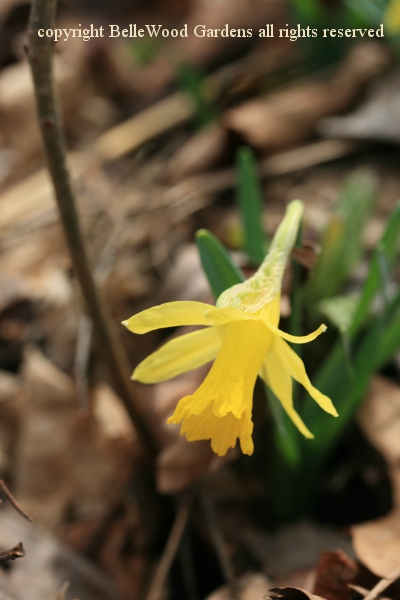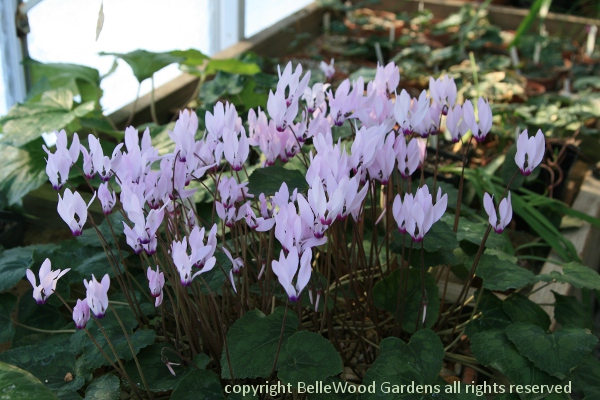| January | March | April | |
| May | June | July | August |
| September | October | December |
Thursday, 25 December 2014 Snowdrops for Christmas Day Galanthus 'Potter's Prelude' and Galanthus elwesii monostictus A lovely gift for the holidays. And remember - now that we're past the solstice -
With new year's wishes for happy days in and out of the garden
Saturday, 25 October 2014 Did you know that there are snowdrops that flower at the other end of the year from Spring? First of these at BelleWood Gardens is Queen Olga's snowdrop, Galanthus nivalis regina-olgae. It always appears about the third week of October, flowering naked, without any foliage. The leaves will appear next Spring. Mine ave never set seed - perhaps it is a single clone and needs to outcross. In common with other sterile perennials it is, vegetatively, very vigorous.
Saturday, 4 October 2014 Autumn flowers in the greenhouse: Oxalis melanosticta Thursday, 2 October 2014 Colchicum in bloom: Colchicum autumnale album plenum. One old common name was "the son before the father." Why so? Because seeds appear in Spring, but flowers in the autumn. The confusion came from cycling seasons as they circle the year's growing seasons, from spring / summer / autumn, and not autumn / winter dormancy / spring.
.
A dainty little ornamental onion. Allium thunbergii 'Ozawa's form' has a neat tussock of grasslike foliage from Spring onward, embellishing it with ample little umbels filled with purple bells in autumn.
Sunday, 14 September 2014 I moved the pots of oxblood lily, Rhodophiala bifida, out of their hot, dry summer rest in the greenhouse. An eary autumn rain and they hurl themselves into bloom, a scant three or four days from empty-looking pots to flowering. Leaves soon follow. I'll move them back indoors before cold weather arrives.
Friday, 22 August 2014 Native to my woodland garden, Jack-in-the-pulpit, Arisaema triphyllum, has a fascinating pattern of growth. Termed paradioecious, because it is not quite dioecus, where male and female flowers are on different plants. Oh, they're on separate plants alright but it is the same plant only at different times. So a young, non-flowering plant is neuter. Then when the tuber gains more storage capacity and the single leaved plant flowers, it does so as male. With even more food reserves the same plant has two leaves, flowers as female, and is fruitful, producing seed as you can see here. How fascinating and marvellous are the things plants do.
Arum italicum 'Pictum' has a peculiar cycle. Here are its vivid seed clusters, very similar to its arisaema cousin. Fresh new leaves will appear in fall, stay evergreen through winter, then flower in Spring. And then go dormant for summer. There must be a reason for this . . . .
.
The seeds of woodland peony, Paeonia obovata 'Alba' are so showy that I am torn between collecting them to plant - or leave them on display to enjoy. The fertile seeds
are that rich metallic blue. Unfertile seeds are usually bright red but we've been very dry. You can see it in bloom in the May entry.
Rain lily, magic lily, surprise lily are all appropriate common names for Lycoris squamigera. It pops up after a late summer rain, naked stem with flowers. Prudently, the leaves wait until Spring to make their appearance.
Sunday, 10 August 2014 Bottlebrush buckeye, Aesculus parviflora. And the reason I am so pleased with this shrub is because I raised it from seed. It was, in fact, inside one of the first wardrobe cartons that came off the moving truck when me relocated from Connecticut to New Jersey all those years ago.
Thursday, 17 July 2014 It is indeed a banana, flowering here at BelleWood Gardens where it grows outdoors, in the ground, year-round. Unfortunately, the bananas it produces are rather dry and not
particularly edible. But they are bananas. Which I find amusing, when my neighbors are producing soybeans, corn, wheat, and other such field crops, or tomatoes and pumpkins.
Monday, 7 July 2014 It's easy to have Hippeastrum (often called - incorrectly - amaryllis) in bloom for Christmas. At least the first year you grow them. Subsequently, mine get a dry resting period in winter. Then in mid May they're repotted, given a through watering and move outdoors for the summer. And as you can see - just like 'Appleblossom' - they generally flower in about 5 weeks. Wednesday, 4 June 2014 What's not to like about peonies. They're extremely long lived, very easy to care for, have beautiful flowers, and are generally ignored by vermin from mice and voles all the way up through rabbits to deer. 'Crinkled White' is a very attractive single.
Double peonies are also quite popular. Only issue is that the many petalled flowers
Iris was goddess of the rainbow, and her flowers certainly come in a wide array of
A simple pairing of Allium giganteum with its purple umbel of flowers (like a
Rain lilies pop in flower scant days after a good downpour. This is a Zephyranthes,
This easy-care beauty is Streptocarpella saxorum. It likes a shady place, moist soil, and flowers year-round. Even all winter when it lives in my cool greenhouse. In summer -
happy outdoors but protect from strong sunlight. And propagate from cuttings. Why? No doubt you have friends who would also appreciate it for a winter windowsill.
Friday, 30 May 2014 Devil's tongue. Snake palm. Umberlla arum. Amorphophallus rivieri. It stinks, like something long dead and rotting. Together with a spathe the color of dead meat, this helps to attracts the flies and beetles that are its pollinators. Stinky enough outdoors in the garden. Significantly more nauseating if it happens to flower in the garage. Lovely tropical foliage though.
Monday, 5 May 2014 Japanese woodland peony, Paeonia obovata 'Alba'. Apparently quite happy here at BelleWood Gardens. I'm finding numerous seedlings, always a happy thing. Two years from seed to seedling, a few more to flowering.
.
It's not disease, not mildew. Lungwort, Pulmonaria, has beautifully silver marked, spotted, splashed leaves. Common name, Latin name - both the same. According to the Doctrine of Signatures, you see, the plant displays a clue for its useful herbal properties. And someone decided the spotted leaves looked like diseased lungs.
Even Latin names may change. This used to be named Anchusa mysotidiflora, the anchusa with forget-me-not flowers. Now it is Brunnera macrophylla, the brunnera with a large leaf. This cultivar is 'Jack Frost', for its silver dappled leaves.
A delightful Japanese woodland primrose, Primul kisoana. It has underground runners that spread it about in a modest fashion. Intensely fuchsia pink flowers. There is a white form but I did not care for it as much. Sunday, 4 May 2014 Virginia bluebells, Mertensia virginica, are aptly named for their sky blue flowers. Except every now and then I find one with flowers - from bud to fully open - in clear pink.
Woodland anemone, Anemone nemorosa, has twig-like rhizomes underground. Plant it, wait a few years, and a pleasant mat on the forest floor will welcome Spring. And then go dormant.
There are two kinds of trillium. The pedunculate have a stem between flower and foliage. Their leaves are plain green, their flowers open wide. This beauty is Trillium grandiflorum, the great white trillium.
The other type is sessile. No stem between flower and leaves, foliage mottled, and the flowers are upright and narrow petalled. T. luteum is typical of these trilliums. Its yellow-greeny flowers have a pleasing citrus scent.
Another sessile trillium that I have here at BelleWood Gardens is T. maculatum, which means "spotted." Certainly true of its silvery green splashed leaves. Typical of trillium, all parts in threes - petals, sepals, leaves.
There are numerous choices if you want to have the standard daffodil color, that yellow so often associated with the hosts of golden daffodils. This sunny jonquilla cultivar is
'Trevithian' which dates back to 1927. Fragrant too, a characteristic of N. jonquilla
I have several cultivars of Narcissus poeticus - older sorts such as 'Old Pheasant Eye' and newer ones like 'Felindre' and 'Cantabile'. All are clearly stamped with the defining traits of the species: crystalline, pure white petals and a short little ruffle of a cup banded red, yellow, green. Reliable, sturdy, and one of my favorite daffodils for the woodland garden.
.
Dating back to 1916, Narcissus 'Thalia' is an older triandrus cultivar with two, sometimes three gently outward facing flowers to a stem. Their delicate fragrance is most noticeable on a warm day.
I also have 'Polar Ice', another, newer riff on elegant white daffodils. Newer, that is, by a scant 20 years since it was introduced in 1936. Call it "heirloom" if you like.
But if we're looking for historical bulbs that have been hanging out in gardens for years and decades and much, much longer, try Muscari armeniacum. Mentioned back in1877, it is a pretty thing with rich blue rounded flowers, rimmed with white. Deer don't eat it, nor rabbts, not even voles chow down.
Thursday, 1 May 2014 Soft pale green bells of Fritillaria verticillata are accompanied by daintily curled bracts. Were they growing amidst brush, as in their native habitats, these would act as tendrils and cling to nearby supports.
Friday, 11 April 2014 A beautiful little blue corydalis, which I believe to be Corydalis fumariifolia .
Heaping snow, repeatedly plowed off the driveway, did not discourage Anemone blanda. The snow is gone (at last!) and the little Greecian windflowers are now nicely in bloom.
Puschkinia scilloides variety libanotica, named for Count Apollo Apollosovich Mussin-Pushkin, a 19th century Russian chemist and plant collector in the Caucasus and Ararat. Notice that the petals fuse to form a little cup at their base unlike the Scilla mischtschenkoana
Tuesday, 8 April 2014 Petals the color of skim milk, with a thin turquoise line down their center. Scilla mischtschenkoana eagerly hurls itself into bloom as soon as the buds push open the soil. Ethereal in the early Spring sun.
The dainty little two leaved scilla, Scilla bifolia is a good do-er, seeding about and increasing nicely. Spring snowflake, Leucojum vernum, has bell-like flowers - starched little petticoats tipped with green. Once again I'm photographing this small, charming, daffodil together with a lens cap for scale. Some day I'll find someone who can tell me if it is indeed Narcissus 'Mustard Seed'. Or not.
.
I know this is indeed Crocus tommasinianus but whether it is 'Ruby Giant', 'Taplow Ruby' or 'Whitwell Purple' - that's where the missing label has sent me adrift. Good deep color. Maybe there's some C. vernus involved . . .
Taxonomists are either splitters, finding a new genus at every turn, or they are lumpers, adding together. So take your choice. Either this is Bulbocodium vernum
or Colchicum vernum. Underground, it does look like colchicum but they flowerin autumn. Ah well, the plant knows who it is, regardless of our labels.
Tuesday, 1 April 2014 Eranthis hiemalis, like gold coins scattered across the sodden leaves from last fall. Friday, 21 March 2014 Crocus tommasinianus opens in the Spring sunshine. Snowdrops make a tardy appearance, delayed by the excessive snow. Leucojum vernum, just a few, and yellowed from their overlong snow cover.. But the winter aconites, Eranthis hiemalis, have sprung into flower. Helleborus Early Purple Group are lovely, in bud but shabby looking. I haven't been able to do the necessary tidying up to their winter damaged foliage. Friday, 27 January 2014 Cyclamen persicum produces a cloud of butterfly-like dainty pink flowers. Freesia alba, Deliciously fragrant, elegant, and an expecially welcome antidote to winter.
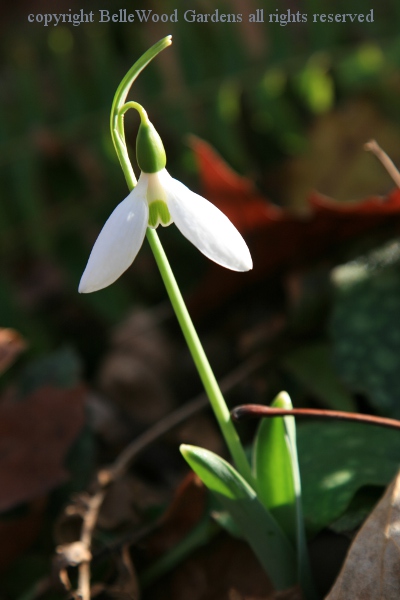
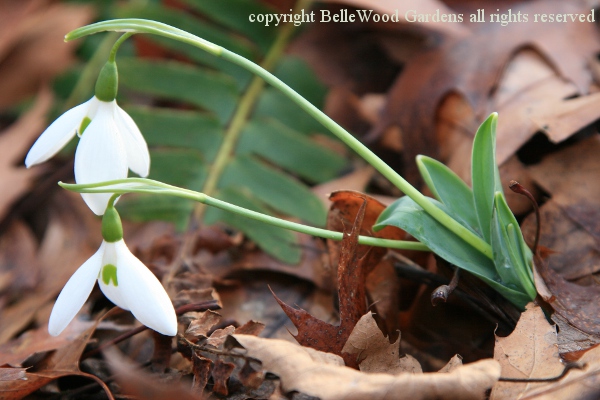
every day is another day closer to Spring.
from Judy, the gardener at BelleWood Gardens

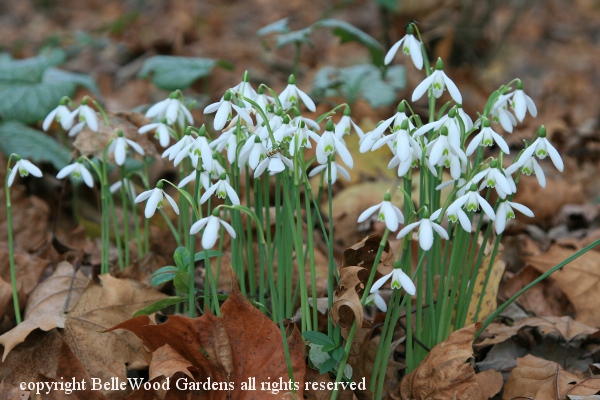









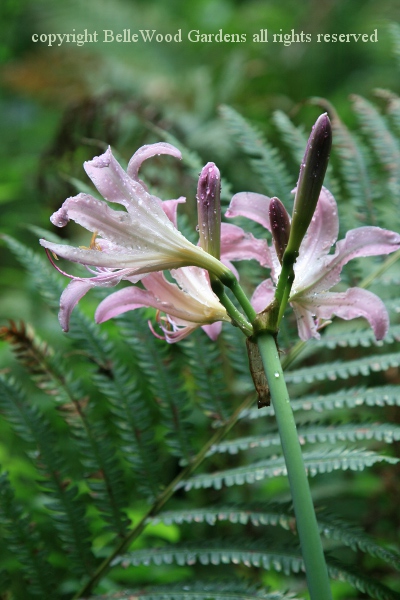

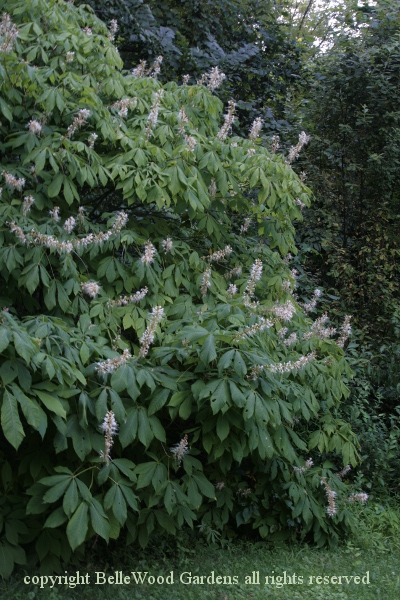




soak up water like blotting paper and become so heavy they fall over. Staking is important.
colors. Dainty Iris pallida, a species, has the added bonus of deliciously fragrant flowers.
tethered balloon) and the yellow daisies of leopard's bane, Doronicum sp.
flower of the west wind. It is Z. rosea and not a Habranthus. Easy to confuse them.



